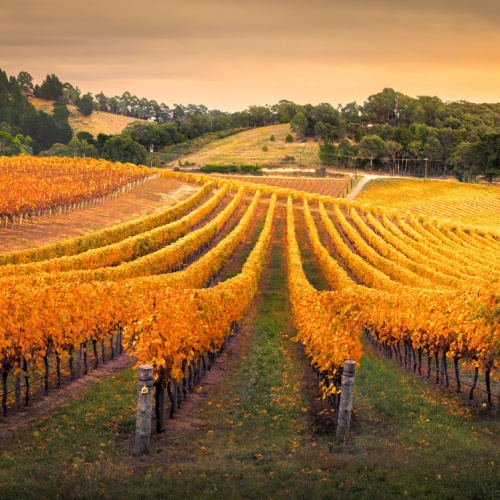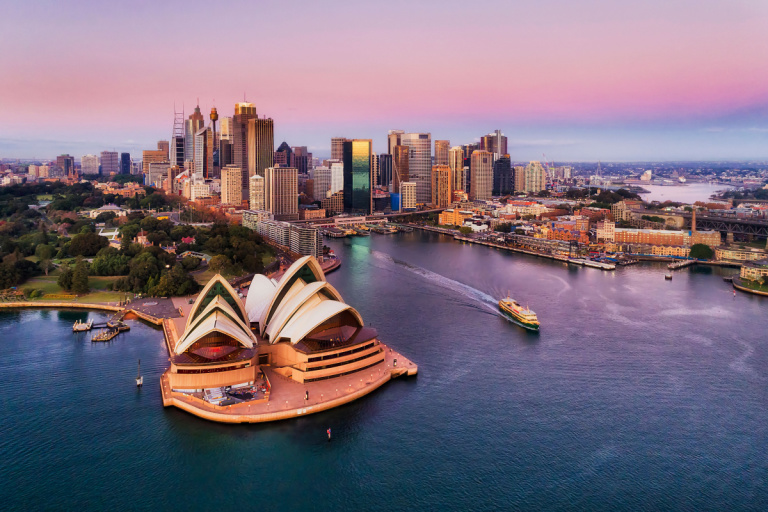
kwest/Shutterstock
When Is the Best Time to Visit Australia?
The best time to visit Australia is during the shoulder seasons of spring (September to November) and fall (March to May). In either season, you’ll enjoy moderate temperatures that are perfect for outdoor activities, lower prices on hotels and flights, and smaller crowds than the peak season.
Here are some of the benefits of visiting Australia during the mellow spring and fall shoulder seasons:
- Mild weather: Australia’s size and geographic diversity means the weather and climate varies by location, but September-November and March-May are when you’ll find the most comfortable weather with little rain and plenty of sunshine. Expect highs from 60° to 80°F and low chances of rain through most of the continent in the spring and fall months.
- Smaller crowds: Peak seasons (summer and winter) can be quite crowded in Australia’s most popular tourist destinations, but the shoulder seasons are a welcome reprieve from the crowds. You’ll appreciate shorter lines, more availability for hotels and flights, and a less hectic atmosphere. This is especially important if you’re visiting popular destinations like Sydney, Melbourne, and the Great Barrier Reef.
- Lower prices: Australia can be expensive to visit, so it’s worth noting that spring and fall visits translate into serious savings. Prices for flights, accommodation, and activities drop during the shoulder seasons due to the lower demand from tourists outside of the peak seasons.
- Diverse wildlife: Australia boasts amazing biodiversity with many species you won’t find anywhere else. You’ll see more wildlife in Australia during the shoulder seasons of spring and fall, when many animals are breeding and active. The chance to spot a mama kangaroo with her joey in her pouch? Priceless!
There’s plenty to do and see in different parts of Australia. Here are some ideas to keep in mind:
- New South Wales: Visit the Sydney Opera House and Harbour Bridge, hike Three Sisters Walk, explore the Blue Mountains, tour wineries in the Hunter Valley region, or go surfing at Bondi Beach.
- Victoria: Visit the lush Melbourne Gardens, head to the Melbourne Cricket Ground, drive the scenic Great Ocean Road along the coast, explore the Yarra Valley wine region, or see the penguins at Phillip Island.
- Queensland: Take a boat out to dive the Great Barrier Reef, explore the dense and wildlife-packed Daintree Rainforest, head to the Australia Zoo or koala sanctuary, admire opals pulled from local mines, or go swimming at Whitehaven Beach.
- Western Australia: Tour the rugged Outback through the red Pinnacles Desert, explore the Margaret River wine region, visit beaches and museums in Perth, dive Ningaloo Reef, or explore ancient Aboriginal sites.
- South Australia: Catch a cricket game or concert at the Adelaide Oval, taste your way through the Barossa Valley wine region, explore the Flinders Ranges and Naracoorte Caves National Park, or see the kangaroos at Kangaroo Island.
- Northern Territory: Visit Aboriginal art galleries in Alice Springs, see the red deserts of the Outback, head to Uluru-Kata Tjuta National Park and Kakadu National Park, swim at the Florence Falls Waterhole, or see the waterfalls at Litchfield National Park.
From September to November and between March and May, Australia is truly at its best. These are the recommended times to visit the continent for the ultimate Aussie experience: Great weather, small crowds, lower prices, and rich landscapes.
 Average Temperatures by Month
Average Temperatures by Month
|
Jan |
Feb |
Mar |
Apr |
May |
Jun |
Jul |
Aug |
Sep |
Oct |
Nov |
Dec |
| New Zealand |
68°
|
68°
|
66°
|
61°
|
57°
|
53°
|
52°
|
54°
|
57°
|
61°
|
63°
|
66°
|
| The Cook Islands |
83°
|
83°
|
83°
|
81°
|
79°
|
77°
|
75°
|
75°
|
77°
|
80°
|
81°
|
83°
|
Climate in Australia
Summer Season in Australia
Australia's summer season runs from December to February since it's in the Southern Hemisphere. Summer in Oz sees warm to scorching-hot weather, depending on the region. Temperatures range from 68°F to 95°F in summer. This is the best time for beach trips, water sports, and festivals around the major cities. The northern regions, like Queensland, are better visited in the spring or fall due to hot, humid conditions in the summer.
Rainy Season in Australia
The rainy season in Australia occurs between November and April in Australia's northern region (like Top End and the tropical north of Queensland). The weather borders on miserable during the summertime rainy season with highs approaching the 90s, humidity near 100%, and heavy downpours. On the bright side, this is when the surrounding landscapes are at their greenest and waterfalls powerfully cascade with the extra rainfall.
Winter Season in Australia
Winter in Australia is between June and August. Unlike winter in some parts of the world, this season is particularly mild (and busy) for Australia. Temperatures range from 50°F to 68°F in many regions. It's not quite a winter wonderland in the traditional sense, but offers a prime time for outdoor activities in places like the Blue Mountains and the Great Barrier Reef. If you're hoping to see a little snow or try some skiing, check out the alpine regions in the south.
Our Recommendations






